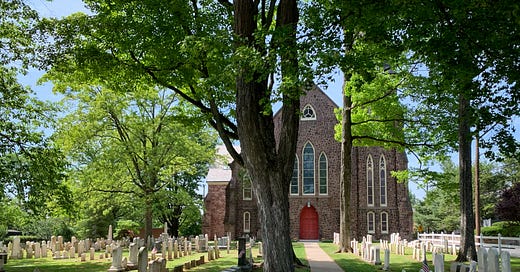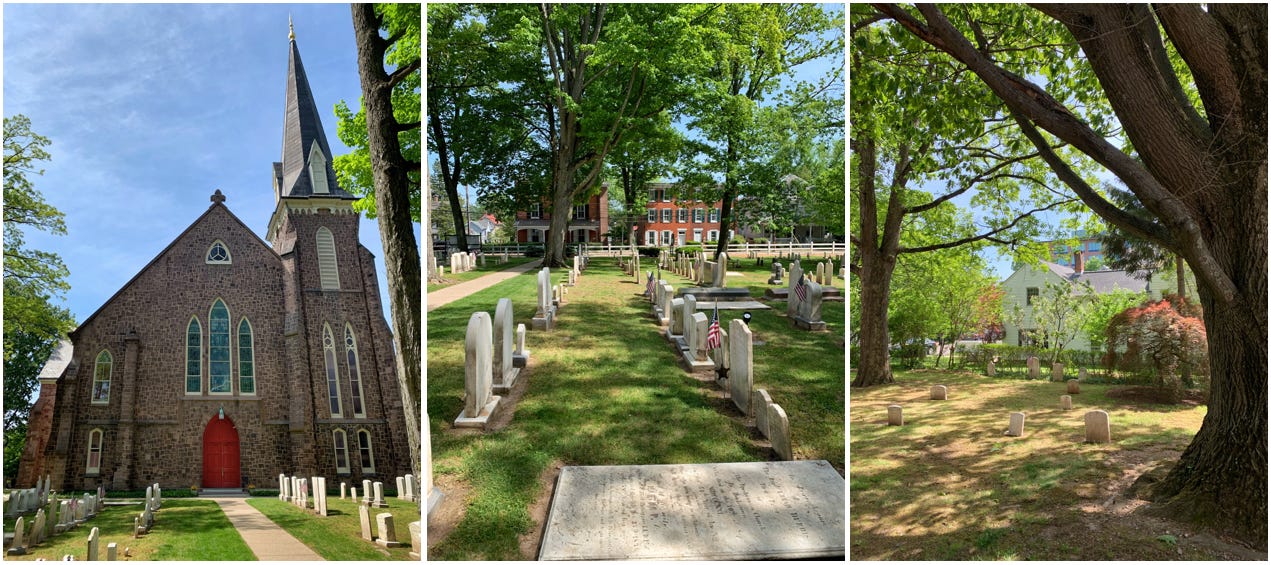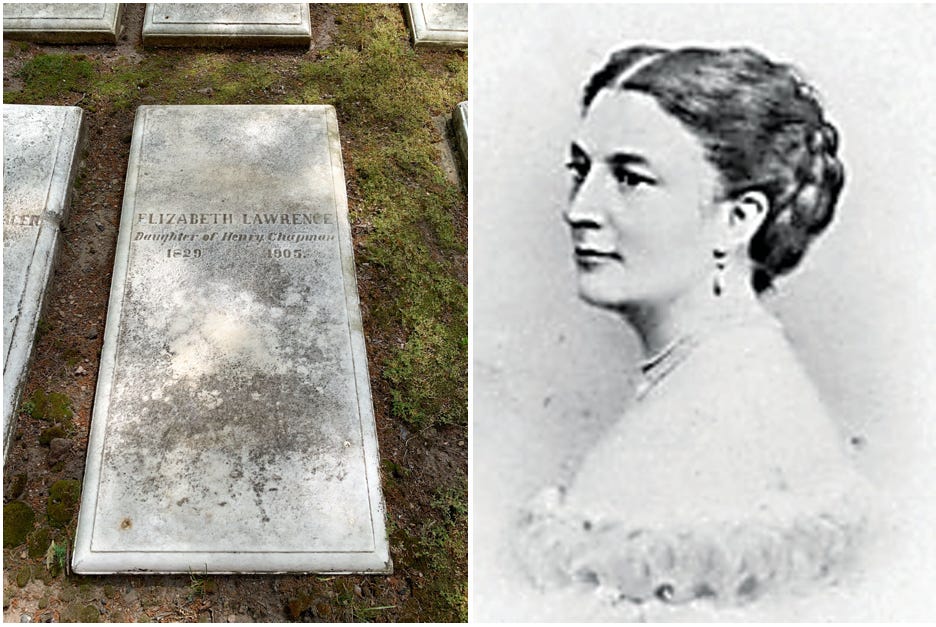Sunday Pastries With the Dead 25
The est. 1815 Doylestown Presbyterian Church Cemetery in Doylestown, PA.
Today’s graveyard is in the same quaint Pennsylvania town as SPWTD posts 22 and 23 and is the oldest cemetery in the area; it’s nestled on a residential street among gorgeous historical houses. According to church records, ground was broken in the circa-1815 graveyard three months prior to the opening of the original church building in order to inter victims of a widespread typhoid epidemic.
The first stone church building was dedicated in 1815; it was torn down in 1871 and the current structure was constructed and opened in 1872.
The graveyard was meticulously laid out in 1816 by early elders, who set aside a large portion for family plots and locals, along with a smaller “stranger’s ground” that contained an area designated for people of color. Families who donated $10 to the church were afforded a plot; individuals who gave $5 were allowed a permanent right to burial. In 1816, the fee for a single grave in the stranger’s ground was $1; it was $5 for a family section. By 1834, the single grave fee was raised to $3.
It being Mother’s Day today, this post’s main focus is on the intriguing women buried here. It’s incredibly rare to find information about women interred in pre-1900s cemeteries—most of them simply have headstones slapped with the qualifier “Wife Of,” and that’s their legacy. It’s called history for a reason…men are the ones who kept the official records and were afforded autonomy and upward mobility—the intricate details of war heroes and politicians are a dime a dozen in the documentation of these places. A yawn-fest, frankly. There are several U.S. Congressmen and wealthy men of note buried here, but let’s cast them aside for once. The records for this spot are deeply considered, so luckily there are a few fascinating female figures to highlight.
Someone needs to make a movie about Elizabeth Chapman Lawrence (1829-1905)—holy hell, what a life this woman led! Elizabeth was an incredibly wealthy socialite once considered “the most popular American woman there was in England,” and she counted James Buchanan, Emperor Napoleon III, William Makepeace Thackery, Charles Dickens, Elizabeth Barrett Browning, and Henry James among her inner circle. She charmed literally everyone she met, from England to Italy to Washington D.C. to this town in Pennsylvania where she ultimately settled after her husband’s untimely death. Thackery called her “easy to fall in love with,” and Dickens referred to her as “that little darling.” Henry Adams even paid homage to her through his Democracy heroine. Widowed and childless at 39, she lavished her favorite nephew, Henry Chapman Mercer (who is buried next to her in this cemetery), with trips abroad and education at Harvard and the University of Pennsylvania Law School. Mercer amassed a legendary industrial object collection that ultimately became the Mercer Museum, which his “Auntie Lela” funded. After Elizabeth died of pneumonia, she left most of her estate to Henry and he built what is now the Fonthill Castle.
With an epic name like Anna Margaretta “Madge” Rile Braden (1858-1939), you just know this woman was a force to reckon with. Madge was a prose writer, poet, and staunch liberal who contributed to magazines and newspapers for the cause. One of her poems is called “Heart-Murder,” so she’s basically my soulmate. She often published under the pen names “Mrs. Findley Braden” and “Madge Rile,” and she wrote over 700 pieces, several poetry volumes, and also served as a newspaper editor. Like Elizabeth, she was childless—yet another standing that set both women apart as deeply ahead of their time.
Susan Price, Jane Scudder, and Hannah Trippet were all Black women who settled in the town in the mid-1800s and are buried in the aforementioned “stranger’s ground” section. Susan was born a slave in Maryland, and her husband Samuel was a slave in Virginia—they fled to Pennsylvania in the 1850s and became quite respected in the community; “Sammy” was even elected the town crier. Jane was listed as a domestic for a local family in the 1860s; Hannah was also a domestic for a nearby physician in the 1850s—records don’t indicate if this was official paid employment for either woman. I’m grateful that all their graves are marked and maintained so that we may know and say their names and thank them for their unsung support of future generations.
Most of the headstones here were without symbols; among the notable few I found were this crossed sword and sheath (indicating a high-ranking military officer or one lost in battle; William Kneedler Shearer was killed in the Civil War Battle of Malvern Hill at age 22), columns (representing a noble life), a hand with a finger pointing up (where the soul went), and a beautifully-preserved lamb (for one who died young) atop the marker for “Our Little Willie.”
We’ll end this entry with a first—y’all, the audible gasp I let out when I stumbled upon this WOODEN HEADSTONE. Not only have I never seen one of these before (because this material simply doesn’t survive long against time and the elements) but I’m in awe that it’s circa-1866, though records show there’s another marble marker in the cemetery that’s considered the original…so perhaps this isn’t quite so old. You can make out Civil War Lieutenant John McCoy’s name, infantry information, birth and death dates, and the traditional Civil War shield design surrounding it all. Incredible!
Until next Sunday, fellow taphophiles!











